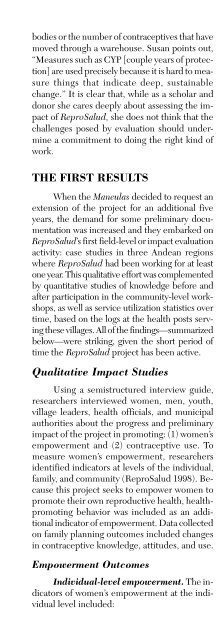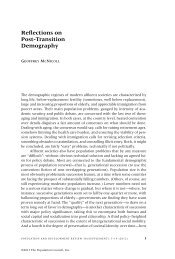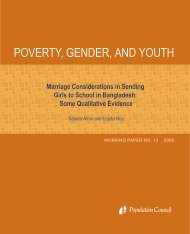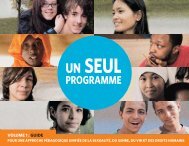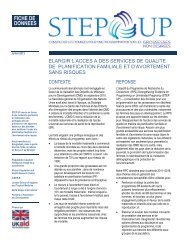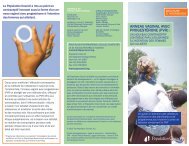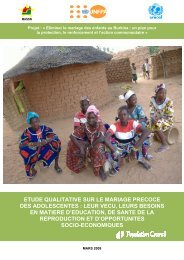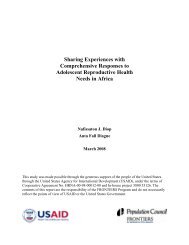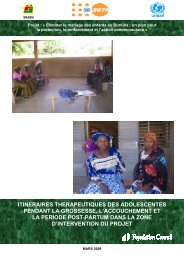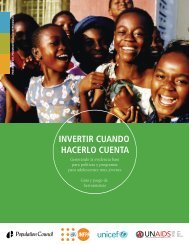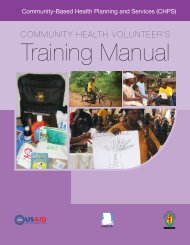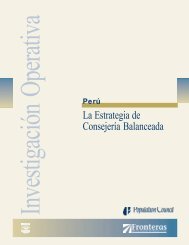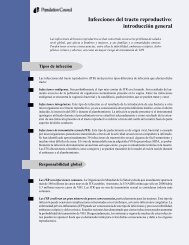QCQ# 10 Alone You are Nobody, Together We Float: The Manuela ...
QCQ# 10 Alone You are Nobody, Together We Float: The Manuela ...
QCQ# 10 Alone You are Nobody, Together We Float: The Manuela ...
Create successful ePaper yourself
Turn your PDF publications into a flip-book with our unique Google optimized e-Paper software.
odies or the number of contraceptives that have<br />
moved through a w<strong>are</strong>house. Susan points out,<br />
“Measures such as CYP [couple years of protection]<br />
<strong>are</strong> used precisely because it is hard to measure<br />
things that indicate deep, sustainable<br />
change.” It is clear that, while as a scholar and<br />
donor she c<strong>are</strong>s deeply about assessing the impact<br />
of ReproSalud, she does not think that the<br />
challenges posed by evaluation should undermine<br />
a commitment to doing the right kind of<br />
work.<br />
THE FIRST RESULTS<br />
When the Maneulas decided to request an<br />
extension of the project for an additional five<br />
years, the demand for some preliminary documentation<br />
was increased and they embarked on<br />
ReproSalud’s first field-level or impact evaluation<br />
activity: case studies in three Andean regions<br />
where ReproSalud had been working for at least<br />
one year. This qualitative effort was complemented<br />
by quantitative studies of knowledge before and<br />
after participation in the community-level workshops,<br />
as well as service utilization statistics over<br />
time, based on the logs at the health posts serving<br />
these villages. All of the findings—summarized<br />
below—were striking, given the short period of<br />
time the ReproSalud project has been active.<br />
Qualitative Impact Studies<br />
Using a semistructured interview guide,<br />
researchers interviewed women, men, youth,<br />
village leaders, health officials, and municipal<br />
authorities about the progress and preliminary<br />
impact of the project in promoting: (1) women’s<br />
empowerment and (2) contraceptive use. To<br />
measure women’s empowerment, researchers<br />
identified indicators at levels of the individual,<br />
family, and community (ReproSalud 1998). Because<br />
this project seeks to empower women to<br />
promote their own reproductive health, healthpromoting<br />
behavior was included as an additional<br />
indicator of empowerment. Data collected<br />
on family planning outcomes included changes<br />
in contraceptive knowledge, attitudes, and use.<br />
Empowerment Outcomes<br />
Individual-level empowerment. <strong>The</strong> indicators<br />
of women’s empowerment at the individual<br />
level included:<br />
• Increase in self-esteem;<br />
• Female control of cash;<br />
• Knowledge of rights; and<br />
• Knowledge of and comfort with one’s body<br />
and reproductive system.<br />
Aside from their association with general<br />
wellbeing, these indicators <strong>are</strong> also generally<br />
linked to positive reproductive health outcomes<br />
and family planning use. <strong>The</strong> following <strong>are</strong> excerpts<br />
from women’s testimonies:<br />
Once a month we come by foot and bus to<br />
the town of Huaraz to take some of our money<br />
from the bank. . . . <strong>The</strong> first time we went in, we<br />
were frightened. <strong>We</strong> <strong>are</strong> not dressed like the<br />
people in the bank. <strong>We</strong> speak Quechua. And we<br />
were not used to working with cash. (Pause) But<br />
we’re not nervous anymore. (A big smile lights<br />
up her face) Now we like it.<br />
Aurelia, project coordinator<br />
in Canchabamba<br />
I tell you, my pride follows me home.<br />
Marilena, young coordinator at the<br />
Pucallpa broom factory<br />
Before, we were like burros, not knowing<br />
anything. Now I feel useful for what I know, that<br />
I can know something too. Before, we knew nothing,<br />
we were forgetful, we were crying, crying.<br />
Now, we know the parts of the body and how<br />
they function, contraceptive method, how a baby<br />
is produced, how to c<strong>are</strong> and eat to have a<br />
healthy baby. How to teach other women and to<br />
determine if a woman needs to go to the health<br />
19


